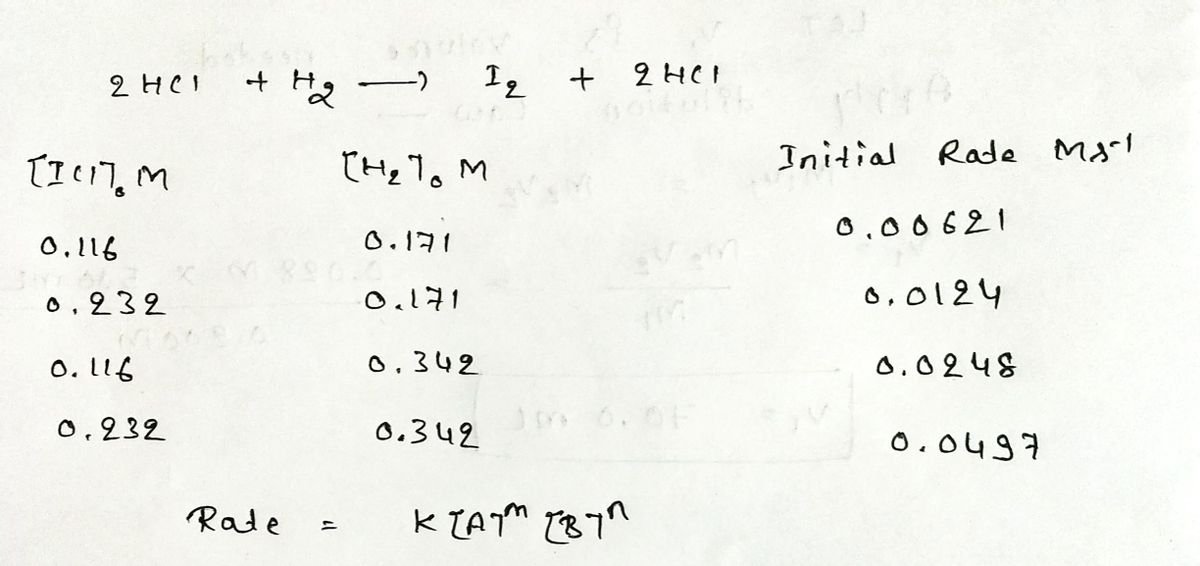following initial rate data are for the reaction of IC1 with hydrogen: 2IC1 + H₂ → I₂ + 2HCl eriment [IC], M [H₂0, M 0.116 0.171 0.232 0.171 0.116 0.342 0.232 0.342 plete the rate law for this reaction in the box below. the form k[A] [B]", where '1' is understood for m or n and concentrations taken to the zero power do not appear. t enter 1 for m or n. = Initial Rate, M. s-¹ 0.00621 0.0124 0.0248 0.0497 M-2.s ¹ -1
following initial rate data are for the reaction of IC1 with hydrogen: 2IC1 + H₂ → I₂ + 2HCl eriment [IC], M [H₂0, M 0.116 0.171 0.232 0.171 0.116 0.342 0.232 0.342 plete the rate law for this reaction in the box below. the form k[A] [B]", where '1' is understood for m or n and concentrations taken to the zero power do not appear. t enter 1 for m or n. = Initial Rate, M. s-¹ 0.00621 0.0124 0.0248 0.0497 M-2.s ¹ -1
Chemistry
10th Edition
ISBN:9781305957404
Author:Steven S. Zumdahl, Susan A. Zumdahl, Donald J. DeCoste
Publisher:Steven S. Zumdahl, Susan A. Zumdahl, Donald J. DeCoste
Chapter1: Chemical Foundations
Section: Chapter Questions
Problem 1RQ: Define and explain the differences between the following terms. a. law and theory b. theory and...
Related questions
Question
![The following initial rate data are for the reaction of ICl with hydrogen:
\[ 2 \text{ICl} + \text{H}_2 \rightarrow \text{I}_2 + 2 \text{HCl} \]
| Experiment | \([\text{ICl}]_0, \text{ M}\) | \([\text{H}_2]_0, \text{ M}\) | Initial Rate, \(\text{M} \cdot \text{s}^{-1}\) |
|------------|------------------|----------------|----------------------------|
| 1 | 0.116 | 0.171 | 0.00621 |
| 2 | 0.232 | 0.171 | 0.0124 |
| 3 | 0.116 | 0.342 | 0.0248 |
| 4 | 0.232 | 0.342 | 0.0497 |
Complete the rate law for this reaction in the box below.
Use the form \(k[\text{A}]^m[\text{B}]^n\), where '1' is understood for \(m\) or \(n\) and concentrations taken to the zero power do not appear. Don't enter 1 for \(m\) or \(n\).
Rate = \(\_\_\_\_\_\_\_\_\_\_\_\_\_\_\_\_\_\_\_\_\_\_\_\_\_\_\_\_\_\_\_\_\_\_\_\_\_\_\)
\[ k = \_\_\_\_\_\_\_\_\_\_\_\_\_\_\_\_ \text{M}^{-2} \cdot \text{s}^{-1} \]](/v2/_next/image?url=https%3A%2F%2Fcontent.bartleby.com%2Fqna-images%2Fquestion%2F7a354f1c-cdfd-41e5-a863-9a86a504af1c%2F8fa961ab-ee9a-43dd-a489-6e6377986405%2Fa7q30ta_processed.png&w=3840&q=75)
Transcribed Image Text:The following initial rate data are for the reaction of ICl with hydrogen:
\[ 2 \text{ICl} + \text{H}_2 \rightarrow \text{I}_2 + 2 \text{HCl} \]
| Experiment | \([\text{ICl}]_0, \text{ M}\) | \([\text{H}_2]_0, \text{ M}\) | Initial Rate, \(\text{M} \cdot \text{s}^{-1}\) |
|------------|------------------|----------------|----------------------------|
| 1 | 0.116 | 0.171 | 0.00621 |
| 2 | 0.232 | 0.171 | 0.0124 |
| 3 | 0.116 | 0.342 | 0.0248 |
| 4 | 0.232 | 0.342 | 0.0497 |
Complete the rate law for this reaction in the box below.
Use the form \(k[\text{A}]^m[\text{B}]^n\), where '1' is understood for \(m\) or \(n\) and concentrations taken to the zero power do not appear. Don't enter 1 for \(m\) or \(n\).
Rate = \(\_\_\_\_\_\_\_\_\_\_\_\_\_\_\_\_\_\_\_\_\_\_\_\_\_\_\_\_\_\_\_\_\_\_\_\_\_\_\)
\[ k = \_\_\_\_\_\_\_\_\_\_\_\_\_\_\_\_ \text{M}^{-2} \cdot \text{s}^{-1} \]
Expert Solution
Step 1

Step by step
Solved in 2 steps with 2 images

Knowledge Booster
Learn more about
Need a deep-dive on the concept behind this application? Look no further. Learn more about this topic, chemistry and related others by exploring similar questions and additional content below.Recommended textbooks for you

Chemistry
Chemistry
ISBN:
9781305957404
Author:
Steven S. Zumdahl, Susan A. Zumdahl, Donald J. DeCoste
Publisher:
Cengage Learning

Chemistry
Chemistry
ISBN:
9781259911156
Author:
Raymond Chang Dr., Jason Overby Professor
Publisher:
McGraw-Hill Education

Principles of Instrumental Analysis
Chemistry
ISBN:
9781305577213
Author:
Douglas A. Skoog, F. James Holler, Stanley R. Crouch
Publisher:
Cengage Learning

Chemistry
Chemistry
ISBN:
9781305957404
Author:
Steven S. Zumdahl, Susan A. Zumdahl, Donald J. DeCoste
Publisher:
Cengage Learning

Chemistry
Chemistry
ISBN:
9781259911156
Author:
Raymond Chang Dr., Jason Overby Professor
Publisher:
McGraw-Hill Education

Principles of Instrumental Analysis
Chemistry
ISBN:
9781305577213
Author:
Douglas A. Skoog, F. James Holler, Stanley R. Crouch
Publisher:
Cengage Learning

Organic Chemistry
Chemistry
ISBN:
9780078021558
Author:
Janice Gorzynski Smith Dr.
Publisher:
McGraw-Hill Education

Chemistry: Principles and Reactions
Chemistry
ISBN:
9781305079373
Author:
William L. Masterton, Cecile N. Hurley
Publisher:
Cengage Learning

Elementary Principles of Chemical Processes, Bind…
Chemistry
ISBN:
9781118431221
Author:
Richard M. Felder, Ronald W. Rousseau, Lisa G. Bullard
Publisher:
WILEY